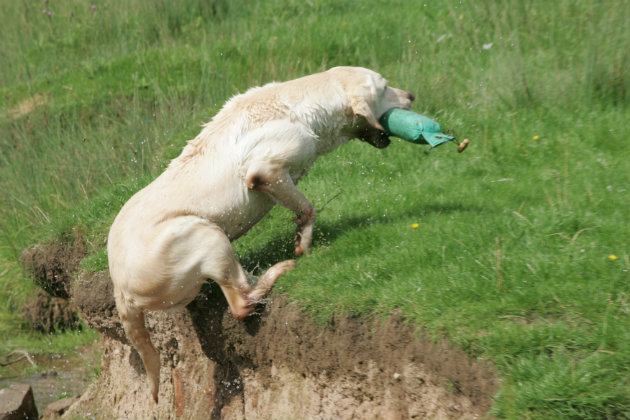Win CENS ProFlex DX5 earplugs worth £1,149 – enter here
How to help a dog with arthritis
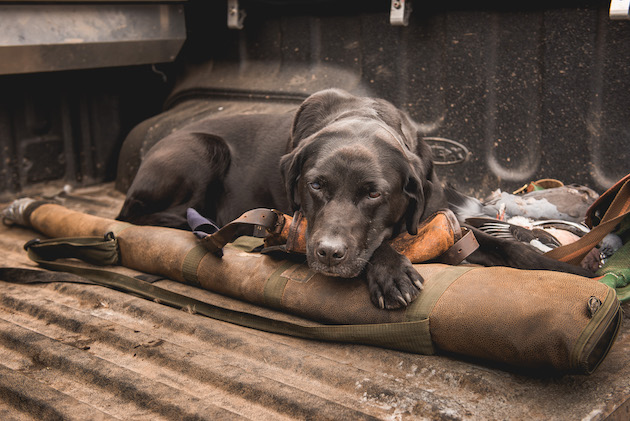 Tired and ready for a snooze, everyone, including Chyula agrees it's been a good day out
Usd 22 april 20 media
Tired and ready for a snooze, everyone, including Chyula agrees it's been a good day out
Usd 22 april 20 media
“My eight year old Labrador is a bit slow to get going now and is usually lame by lunchtime, when I rug her up and put her in the vehicle. She seems a bit young to call it a day. How can you help a dog with arthritis?”
Many working dogs are affected by arthritis and it can be a very debilitating and frustrating condition. There are a number of steps you can take to help a dog with arthritis, to improve quality of life. (Read about a new injection for arthritic dogs here.)
Weight control
Controlling your dog’s weight by feeding a healthy diet and keeping your dog fit by providing regular exercise are probably the most significant things you can do to prevent or delay the onset of arthritis.
Extra weight puts undue stress on joints and hormones produced by excess fatty tissue can also lead to inflammation. Starting young and stopping your dog getting fat in the first place is much easier than trying to reduce the weight of a dog that has become obese. Indeed, by the time a dog has become obese, that extra weight alone will have already damaged joints such as the shoulder, hips, elbows and stifle.
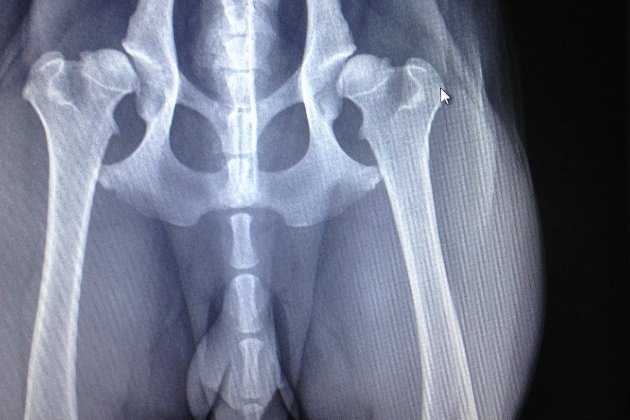
Most patients are affected by secondary osteoarthritis, such as this dog’s X-ray
What is arthritis?
Arthritis can be defined as inflammation of a joint or joints that is characterised by pain and/or stiffness of the affected parts. Immune mediated (rheumatoid) arthritis is uncommon in dogs and most patients are affected by secondary osteoarthritis, caused by abnormal juvenile joint development (think hip or elbow dysplasia), trauma or infection. The pathological process is complicated but involves:
- Degeneration and eventual destruction of the cushioning cartilage.
- Inflammation and thickening of the joint capsule.
- The formation of peri-articular extra bone (osteophytes).
- Increased joint fluid followed by loss of joint fluid.
- Tendonitis, bursitis and lots of other itis.
- Excessive stimulation of nerve ends, thus increasing pain.
You end up with a thickened, swollen, stiff, painful joint. In our working dogs, the joints most commonly affected are elbows (in spaniels and in retrievers, especially those whose parents had elbow scores of 1 or more), stifles/knees (retrievers) and hips (especially in retrievers whose parents had average to poor hip scores).
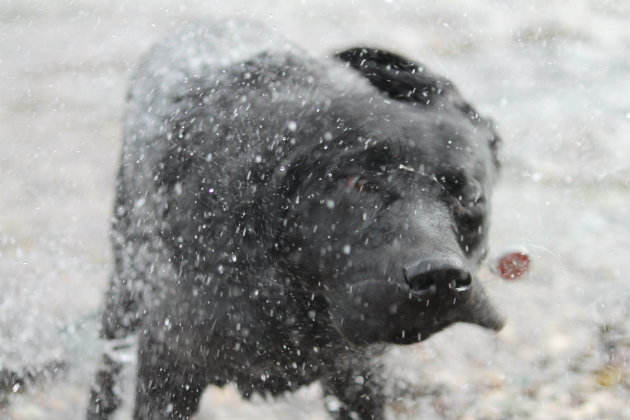
Drying wet and cold dogs takes little effort but can increase working life
How can you prevent arthritis in dogs?
You can’t. Selective breeding, which should include hip and elbow scoring certainly helps. The condition is familial but most bitches at breeding age are too young to have shown symptoms. Keeping a lean bodyweight, warming up/down before and after heavy exercise, controlling exercise in early life, promoting good muscle mass by regular exercise and minimising trauma to the joints (think before you lob that dog over that fence) all help.
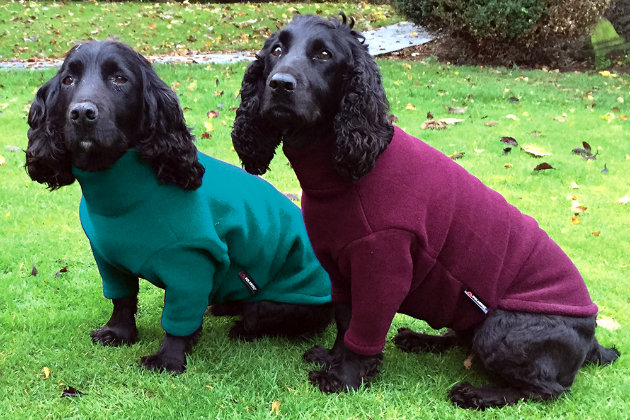
Coats like Equafleece are good for warming up cold, damp dogs
Weekend warriors
My personal view is that the problem with many working dogs is the weekend warrior issue. Many dogs do little but sit around during the week and then are exposed to difficult terrain and weather on a Saturday. Any dog that is stiff on a Sunday morning needs a change of management!
Don’t forget it is not weak to show a little care and consideration. Drying wet and cold dogs takes little effort and fleece coats are cheap. Soft bedding to support joints will also reap benefits. Paying attention to all these aspects will increase working life.
Medication to help a dog with arthritis
There are various ways to treat arthritis, including nutritional supplements and medications. Glucosamine and chondroitin sulphate help decrease joint inflammation and improve the body’s ability to repair tissues. Dietary supplements can help to delay the onset of arthritis and proprietary preparations such as YuMove are claimed to reduce stiffness, promote better joint health and increase mobility.
NSAIDs (non-steroidal anti-inflammatory drugs) have shown positive benefits in treating dogs with arthritis. Though some NSAIDs have undesirable side effects, these have been significantly reduced with the advent of more recent, better targeted NSAID treatments. There is now no reason for dogs with arthritis to suffer in pain.
Steroids reduce inflammation at nerve endings, which in turn will reduce pain. Unfortunately they cause increased hunger, thirst and urination. Their prolonged use can increase the risk of secondary infections and, over time, actually cause further damage to the joints. Corticosteroid therapy is therefore typically reserved for the more severely affected individuals that are in most pain. If your dog has arthritis, provide a soft, comfortable bed to take pressure off his joints when resting and use ramps to help him get up any stairs he needs to climb and to get into the car.
Don’t use ibuprofen. It is toxic to dogs.
Canine arthritis checklist
- Arthritis is the most common cause of chronic pain in dogs. Four out of five older dogs suffer from it.
- It is a disabling and progressive disease, which initially affects moving joints but eventually impacts the whole dog. This leads to loss of quality of life, resulting in many dogs being put down.
- Canine arthritis is a useful website
- All breeds can suffer from arthritis, but some are more susceptible than others. Large to medium-sized dogs tend to suffer the most, and both golden retrievers and labradors are particularly vulnerable.
- There are many signs of the disease, several of which are easy to overlook or dismiss simply because your dog is getting old. Indications to look out for include difficulty in getting comfortable when settling into a bed, lameness, reluctance to go for walks, changes in temperament and even licking of joints.
- Dogs are remarkably stoic in accepting pain. They don’t whimper or yelp as you might expect them to, but simply put up with it.
- Arthritis isn’t a new disease. Signs of it have even been found in the bones of dinosaurs. Despite huge sums of money having been spent investigating it, no cure has yet been found.
- There are many ways in which you can manage the disease in your dog, ranging from adapting the environment in which it lives, to avoiding damaging exercise. Just because your dog still wants to come shooting with you doesn’t mean it is fit to do so. Dogs are remarkably loyal and they will try to stay with you for as long as they can.
Related Articles
Get the latest news delivered direct to your door
Subscribe to Shooting Times & Country
Discover the ultimate companion for field sports enthusiasts with Shooting Times & Country Magazine, the UK’s leading weekly publication that has been at the forefront of shooting culture since 1882. Subscribers gain access to expert tips, comprehensive gear reviews, seasonal advice and a vibrant community of like-minded shooters.
Save on shop price when you subscribe with weekly issues featuring in-depth articles on gundog training, exclusive member offers and access to the digital back issue library. A Shooting Times & Country subscription is more than a magazine, don’t just read about the countryside; immerse yourself in its most authoritative and engaging publication.






